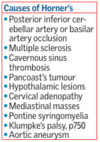12 - Ophthalmology Conditions 2 Flashcards
What are some causes of optic neuritis?
- MS
- Infection e.g syphillis
- Drugs e.g ethambutol, methanol
- Diabetes
- Vitamin deficiency

What are some risk factors for developing optic neuritis?
- Age 20-40
- Female
- Caucasian
- FHx of MS
How does optic neuritis present?
- Unilateral loss of vision over hours or days
- Dyschromatopsia/Red desaturation
- Eye movements painful
- Flashing lights
- RAPD

What is the prognosis with optic neuritis?
- Usually resolves in 2-6 weeks
- 50-80% go on to develop MS in next 15 years
What is the treatment for optic neuritis?
- High dose methylprednisolone IV for 72hrs
then
- PO Prednisolone for 11 days

What is the difference between orbital and periorbital cellulitis?
(IMAGE IMPORTANT)
Orbital: Infection of the tissues posterior to the septum and it is life threatening so an emergency. Usually from paranasal sinus, dental or occular infection
Periorbital: Infection of the tissues anterior to the septum. Usually from sinus infections or facial skin lesions

What is the presentation of periorbital cellulitis and how can you rule out orbital cellulitis?

- Swollen red hot eyelids
- Features that rule out orbital: absence of painful eye movements, absence of visual impairment, absence of diplopia
- If in doubt treat as orbital cellulitis as this is life threatening

What is the treatment of periorbital cellulitis?
- PO co-amoxiclav
- Admit if child or high risk of progression to orbital cellulitis
- Safety net to return if any red flags or not responding after 48 hours

How does orbital cellulitis present?
- Swollen red eye
- Pain on eye movement and reduced eye movements
- Diplopia
- Proptosis
- RAPD
- Fever
- Reduced visual acuity

What are the complications with orbital cellulitis that make it an emergency?
- Subperiosteal and orbital abscess
- Visual loss due to optic neuritis and CRAO
- Meningitis
- Brain abscess
- Cavernous sinus thrombosis

When should you CT in orbital cellulitis and what are some red flags that an orbital cellulitis needs urgent action?
Eyelid oedema and erythema OR failure to respond to 48hr abx PLUS ONE RED FLAG:
- Proptosis
- Chemosis
- Ophthalmoplegia
- Relative afferent pupillary defect (RAPD)
- Systemically unwell 6. Painful eye movement
- Altered visual acuity

How is orbital cellulitis managed?
- Admit for promt CT (if indicated as radiation exposure to young), ENT and Optho assessment
- IV Abx (Ceftriaxone +/- Metronidazole if sinus infection)
- Surgical drainage of any abscesses to prevent meningeal involvement and cavernous sinus thrombosis

How can you tell the difference between episcleritis and scleritis?
Episclera lies superficially so the vessels will move when probed with a cotton bud and blanch when 10% phenylephrine is put on them
This won’t happen with sclerla vessels as they are deeper

How does episcleritis present?
- Typically not painful but can be mild pain
- Segmental redness (rather than diffuse) in lateral sclera
- Foreign body sensation
- Dilated episcleral vessels
- Watering of eye
- No discharge

What types of patients does episcleritis usually present in?
MOSTLY IDIOPATHIC
- Young middle aged women
- Inflammatory disorders e.g IBD, RA

How is episcleritis managed?
- Self limiting in 1-4 weeks
- Symptomatic relief with simple analgesia, cold compresses, artificial tears
- Safety net

What is scleritis and why is it more serious than episcleritis?
- Generalised inflammation of the sclera with oedema of the conjunctiva
scleral thinning, and vasculitic changes
- URGENT REFERRAL as necrotising scleritis can lead to perforation of the sclera and is sight threatening

What are the causes of scleritis?
Usually not infectious, it is autoimmune related

How does scleritis present?
- Diffuse red eye
- Severe dull pain made worse on occular movements
- Headache
- Photophobia
- Reduced visual acuity

How is scleritis managed?
URGENT OPHTHO REFERRAL
Anterior/Non-necrotising:
- Oral high-dose prednisolone
- Oral NSAIDs
Posterior or Necrotising:
- Immunosuppression for underlying autoimmune condition e.g clophosphamide or rituximab
- Course of methylprednisolone
- If globe perforation need surgery

How can you detect a cataracts with a pen torch?
There will be a defect in the red reflex. Cataracts will prevent light from getting to the retina.
What are indications of cataract surgery and what can you expect to change with your vision from it?
Indications: Symptoms are troubling, lifestyle is restricted, or if unable to read a number-plate at 20 metres (and they need to drive)
Changes:
- Improve colour vision
- Dazzle/glare often remains after
- Improved visual acuity as put refractive lens in, may need distance glasses
- Visual acuity may not return to normal as may be underlying co-existing AMD
What are Drusen in AMD?
- Soft Drusen lift RPE from Bruch’s membrane. This can cause VEGF release so encourages neovascularisation and progression from dry to wet AMD

How does neovascularisation in wet AMD cause vision loss?
-Disciform scar in macula that leads to a blind spot (scotoma)
-New vessels develop from choroid layer and grow into retina, leaking fluid or blood which causes oedema and vision loss.























































